The MSI B450 Tomahawk Motherboard Review: More Missile Than Axe
by Gavin Bonshor on December 11, 2018 8:00 AM EST- Posted in
- Motherboards
- AMD
- MSI
- Zen
- AM4
- Ryzen
- Tomahawk
- Ryzen 2
- B450
- Entry Level
- MSI B450 Tomahawk
Visual Inspection
The B450 Tomahawk is an ATX sized motherboard which comes from MSI’s Arsenal Gaming range with a heavy focus on value. The board does not have an overburdened PCB, which gives the black and grey color more pop. The patterning across the board resembles a circuit board (of sorts) and the light gunmetal grey MOSFET/chipset heatsinks offer a sense of uniformity to the design. The B450 Tomahawk includes a single section of eight RGB LEDs in a vertical alignment on the underside of top right-hand side of the board. Users wishing to expand upon have access to two 5050 RGB headers which are both capable of supporting strips with a maximum of 12 V. Comparing the B350 Tomahawk to the B450 Tomahawk, the heatsink follows a much sleeker design with MSI focusing a lot of its attention on improving the power delivery cooling capabilities, as well as the cleaner and more neutral looking aesthetics.
MSI’s implementation of the PCIe layout focuses around the center of the board with the solitary and full-length PCIe 3.0 x16 slot getting a garnishing of Steel Slot armor protection. This is designed to minimize the risk of slot damage from heavy graphics cards when in transit. The rest of the available PCIe slots all conform to the PCIe 2.0 interface, with a second full-length PCIe 2.0 x4 slot for add-in cards.
The improved firmware over the first iteration of AM4 motherboards allows for faster memory. The B450 Tomahawk supports DDR4-3466 straight out of the box, and with the four available RAM slots it allows for a maximum capacity of up to 64 GB. Unbuffered ECC is also supported.
The B450 Tomahawk has better than average SATA support for a B450 board, with a total of six SATA ports. Four of the ports are from the B450 chipset, and two are driven directly from the CPU internal IO. The ports are split across the bottom right-hand side of the board with four of the ports banked together with right-angled connectors, whereas the other two ports are on the bottom of the boards PCB with cheaper straight connectors. The available SATA ports do have support for RAID 0, 1 and 10 arrays.
Also on storage, there is a single PCIe 3.0 x4 M.2 slot with support for PCIe and SATA drives, up to a maximum size of M.2 22110. Populating the M.2 slot with any drive does disable two SATA ports.
In terms of fan headers, there are six 4-pin headers which are split into three different areas; one for the CPU, one for a water pump/AIO fan and four designated for system fans. The rear panel offers eight USB ports in total (which is fairly standard for a motherboard in this price range) and users looking to expand on this can do so with a pair of USB 2.0 headers and a USB 3.1 Gen1 header. Power to the motherboard is provided through a 24-pin ATX power connector and for the CPU, an 8-pin ATX 12 V power input is present. Users looking to reset the CMOS can do so with an old-fashioned jumper which is located right next to the battery.
Focusing on the power delivery on the B450 Tomahawk, and we have a total of six phases which is split into a 4+2 configuration. This is the maximum supported limit of the Richtek RT8894A PWM controller which this board has. On the CPU section of the power delivery, each of the four true phases gets a pair of ON Semiconductor 4C029N high side MOSFETs which is complemented by a further two 4C024N low side MOSFETs also from ON Semiconductor. The SoC area, much like the CPU area, also uses ON Semiconductor MOSFETs with two 4C029 high side and two 4C024N low side assigned to each of the two SoC phases. A total of eight inductors are present across the power delivery which is split into two banks, four for the VCore and two for the SoC which gives a 4+2 power delivery configuration.
| AM4 Motherboard Power Delivery Comparison | |||||
| Motherboard | Controller | H-Side | L-Side | Chokes | Doubler |
| ASRock B450 Gaming ITX/ac |
ISL95712 (6+2) | 10 | 10 | 8 | - |
| ASRock B450 Gaming K4 |
ISL95712 (3+3) | 12 | 9 | 9 | - |
| ASRock X470 Taichi Ultimate |
IR35201 (6+2) |
16 | 16 | 16 | 8 |
| Biostar X370GTN | ISL95712 (4+3) |
7 | 7 | 7 | - |
| Biostar X470GTN | ISL95712 (4+3) |
7 | 7 | 7 | - |
| GIGABYTE X470 Gaming 7 Wi-Fi |
IR35201 (5+2) |
12 | 12 | 12 | 5 |
| MSI B350 Tomahawk | RT8894A (4+2) |
8 | 12 | 6 | - |
| MSI X370 XPOWER GAMING TITANIUM |
IR35201 (6+2) |
10 | 16 | 10 | 5 |
| MSI X470 Gaming Plus | RT8894A (4+2) |
14 | 14 | 11 | - |
| MSI B450 Tomahawk | RT8894A (4+2) |
12 | 12 | 6 | - |
When you compare the key differences between the power delivery featured on the previous Tomahawk to this, MSI has certainly upped their game so to speak. Firstly, MSI has ditched the more value-focused NIKOS MOSFETs in favor of those from ON Semiconductor, and the new B450 opts for four MOSFETs per phase.
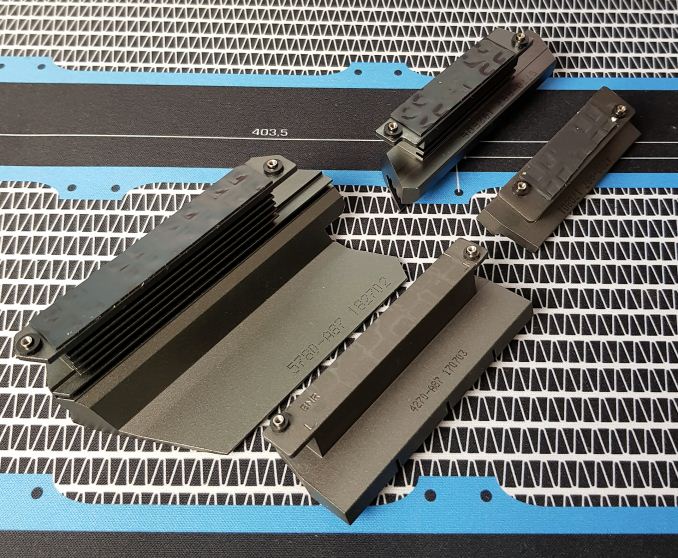
MSI B450 Tomahawk power delivery heatsinks (bottom left) next to the B350 Tomahawk heatsinks (top right)
The other major improvement over the previous generation Tomahawk comes through the included heatsinks. The B450 Tomahawk not only has much cleaner and stylish looking heatsinks, but MSI has both increased the mass and extended the VCore MOSFET heatsink to have a larger area on top. This should help with longevity and stability as far as temperatures go. One of the usual caveats of a ‘refresh’ is that manufacturers sometimes recycle PCB designs and only change the visual aspects, but in this case the B450 Tomahawk is a step up.
That being said, the audio area of the PCB on the B450 Tomahawk looks a little underwhelming in comparison. MSI has implemented the older Realtek ALC892 HD audio codec, which isn’t strange given the boards pricing. However it should be noted that the audio PCB on the B350 Tomahawk is certainly heftier with a total of ten Nippon Chemicon audio capacitors, which dwarves that of the B450 Tomahawk which has only four available.
As previously mentioned, the rear panel offers a total of eight USB ports. The B450 Tomahawk offers two USB 3.1 Gen2 ports, a Type-A and a Type-C. Other connections include a DVI-D port and a HDMI 1.4 port, a single PS/2 combination keyboard/mouse port, and a Realtek RTL8111H Gigabit networking controller. MSI has included a BIOS Flashback+ button as well.
What's in The Box
The accessory bundle as expected is rather basic but contains all the vital necessities to get a system up and running out of the box. MSI has scrimped a little on the SATA cables as they have included only two. Also present is a user manual, a driver and utility installation CD, a rear IO shield and an M.2 mounting screw.
- User manual and quick installation guide
- Driver installation CD
- 1 x M.2 installation screws
- 2 x SATA cables (1 right-angled, 1 straight-angled)
- Rear IO shield
- MSI Gaming shield sticker
- MSI thank you card


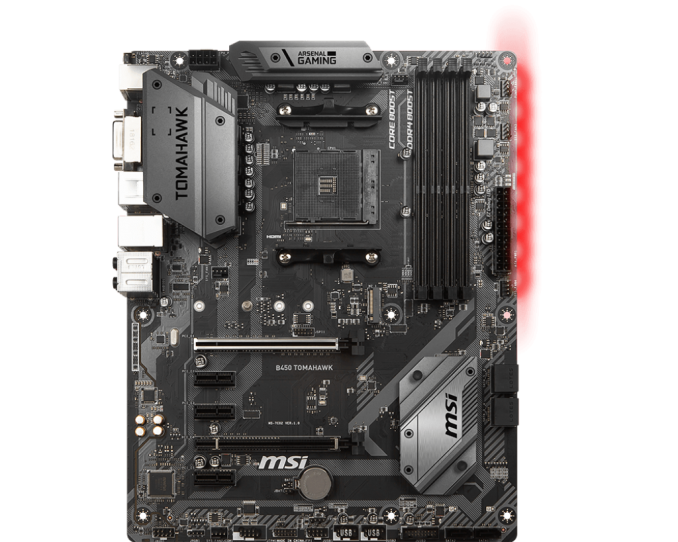
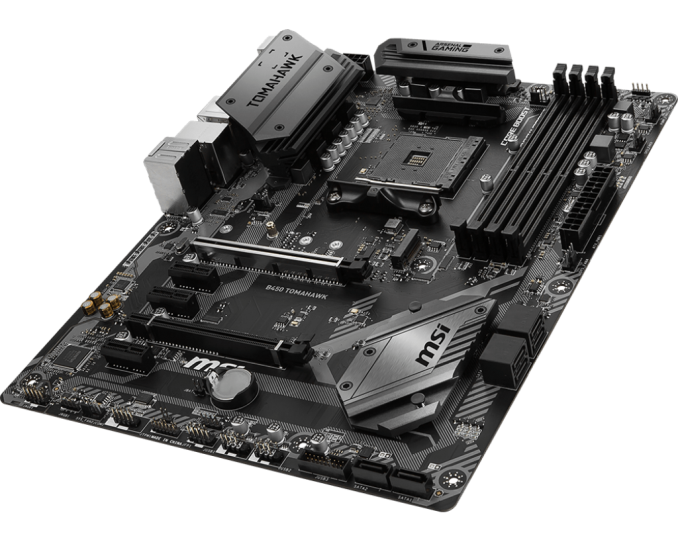
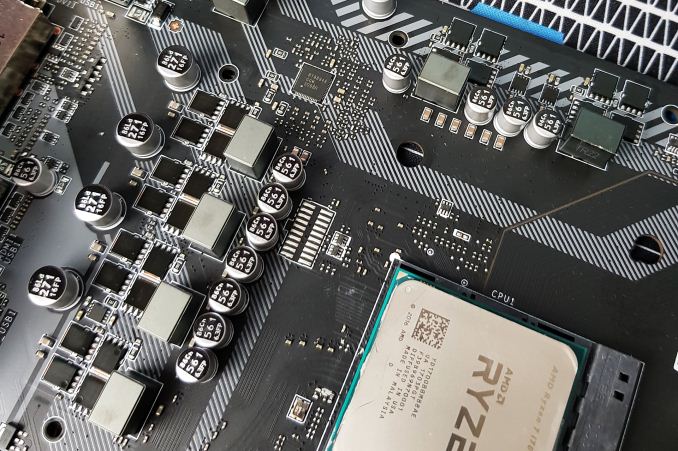
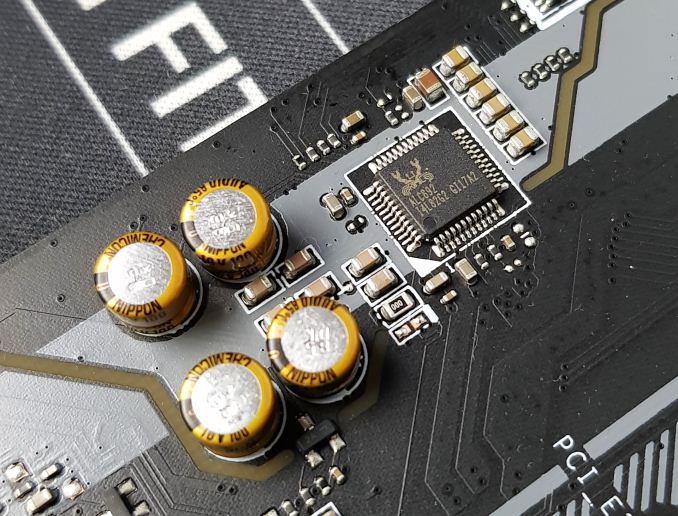

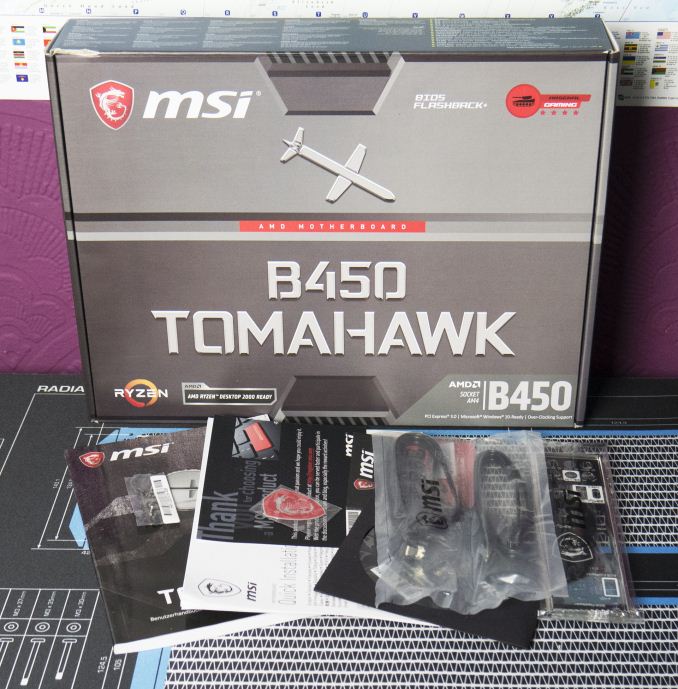








36 Comments
View All Comments
DrHansGruber - Tuesday, December 11, 2018 - link
Gaming performance looks like it's taken a not insignificant hit compared to the B350 Tomahawk.gavbon - Tuesday, December 11, 2018 - link
That does seem to be the current trend from X370/B350 to X470/B450 from the testing. It's still within a 1-3% margin of error although more like 7% in Total War. This could be the developer changing the benchmark slightly with a game update which would make more sense, given the other gamers tested are more in line with other boards.ianrumford - Tuesday, December 11, 2018 - link
A cautionary tale.I just bought this board during Black Friday sales (~£90). Nice spec and good price. But.
It came with the 120 bios installed but didn't recognise both 16GB sticks of my
G.Skill 3200 Trident Z for AMD ("TZRX"). I got the board to boot with just one stick though at 2133.
The latest bios (130) includes support for AGESA 1.0.0.6 which has better memory compatibility.
I used the bios m-flash utility to upgrade to 130 and all seemed well till
around 70% when I was briefly called away and returned to find a blank screen. The board did not boot.
The Tomahawk has a well-advertised feature call BIOS Flashback where you can recover the bios
using the special hardware port that takes a FAT32 usb with the bios on it.
The marketing collateral on Newegg says of BIOS Flashback:
"Run into trouble when updating your BIOS? Simply flash the old BIOS version
back and continue gaming within minutes with BIOS Flashback+. BIOS Flashback+
even works without a CPU, memory or graphics card installed!"
But the board refused to even load the 130 bios. Googling around this seems to suggest
there is something wrong with the bios file.
I tried to (re)load the 120 bios using flashback. This bios loaded in the way the
manual says it should, but the board still did not boot.
I've tried the other two bioses available on the MSI website and while they seem
also to load ok, still no joy.
I opened a call with MSI tech support and they have confirmed pretty much that
BIOS Flashback does not always work.
I've contacted the reseller to negotiate a replacement. In UK law a product that
does not do what it claims to be able to do is not of "merchantable quality".
gavbon - Tuesday, December 11, 2018 - link
Sorry to hear you've had that experience! It sounds more like a straight RMA and swap to me, but obviously, I cannot speak on behalf of the manufacturer. If I had the same issue which these things can happen, I would RMA too. Where did you buy it from? Are they willing to replace the board?ianrumford - Tuesday, December 11, 2018 - link
Hi,
I'd rather not say at this point who the reseller until they have had a chance
to step up to the plate. I think they are UK-only. I've bought from them before
and they gave good prices and good service although I've never had to return
anything.
There are a few observations I'd make though, two MSI-specific and one more
general.
First is the MSI marketing folk are over-egging the product in a way the tech
folk can't deliver on.
Second is their testing of new bioses: the latest (130) bios failed for me both to
flash and even be recognised as valid for flashback.
Third is the more general point of how fraught bios update still seems to be.
Its been a while since I built a new system but have been surprised how many
reports there are of updates failing, even though technologies like dual bios
and flashback have become more common. That's qualitative of course and I've
never seen any stats on update failures. Also I've never written any code for
hardware so have no idea of the challenges faced writing an utterly paranoid
update process. Perhaps the development and/or testing time is just too
expensive and maybe its cheaper for manufacturers just to take the hit on RMAs.
Wingartz - Tuesday, December 11, 2018 - link
i had an issue like that also with MSI but the X58 mobo (damn those mobos) flashed via usb to the newest version and it bricked right away, searched in Google and found that specific model always got bricked when flashing via usb, it seems after all this years they have't got the issue solvedplonk420 - Friday, December 14, 2018 - link
wowch, that was an expensive board to brickrocky12345 - Monday, December 17, 2018 - link
That is why I like boards like Gigabyte and their dual bios because if something goes wrong you just flip the switch and are up and running again. On my own Gigabyte board my second bios is something like version 1 since I have never flashed the second bios on it ever just the main bios which has always worked like a charm so far.OolonCaluphid - Wednesday, December 12, 2018 - link
I have the MSI B450m Mortar - the mATX little brother for this board.I also have absolutely no joy getting it to play with my DDR4 3200mhz ram - Kingston Hyper X. It works perfectly with my 32gb 3000Mhz Kingston Hyper X kit, however. So I refuse to believe claims that these boards support 3466Mhz ram, unless it's on the QVL list and also you get a bit lucky.
Sound quality is also poor, but that's not a problem for my uses.
Sorry to hear of your BIOS problems. real PITA. Here's hoping the retailer see you right.
3DoubleD - Wednesday, December 12, 2018 - link
I'd second that. I really think Anandtech should run an article on this because it took me a bit by surprise, although I had heard of compatibility issues.I recently put together a Ryzen 2600x + Gigabyte Gaming 7 + 2x16GB DDR3200 system and what a pain it is to get memory running at the correct speeds. I even carefully grabbed a RAM kit that was listed on Gigabyte's qvl list for the board at the rated speed, but even after bios update the XMP did not boot.
Eventually I used one of the Ryzen ram timing calculators and got it to boot at 3200 MHz, but I had some stability issues so I dropped to 3133 MHz with slightly faster timings (probably not much of a performance tradeoff).
Apparently you need to buy Samsung B-die dimms, but I had a really hard to finding any during black friday sales and got a good deal for the kit I ended up buying (that was supposedly tested by Gigabyte at the rated speed and timings).
Anyway, a RAM buyers guide for AMD systems would be worthwhile IMO because it is NOT as straightforward or plug & play as you'd think it would be in 2018 (almost 2019).